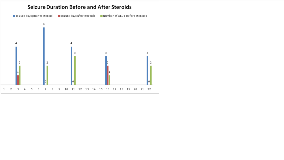The Use of Steroids for the Treatment of Epilepsia Partialis Continua
Abstract number :
3.218
Submission category :
4. Clinical Epilepsy / 4C. Clinical Treatments
Year :
2018
Submission ID :
501290
Source :
www.aesnet.org
Presentation date :
12/3/2018 1:55:12 PM
Published date :
Nov 5, 2018, 18:00 PM
Authors :
George Ansoanuur, University of Texas Health Science Center; Yvo Rodriguez, University of Texas Health Science Center; and Shaun Smart, University of Texas Health Science Center
Rationale: Epilepsia partialis continua (EPC) is a form of focal motor status epilepticus that can be very difficult to treat. While there are first and second-line therapies established for convulsive status epilepticus, recommendations for the management of epilepsia partialis continua are not well established. Recent research in the field explores the role of inflammatory mediators in the neuromodulation cascade. At our center, we used high dose steroids for the treatment of epilepsia partialis continua. We hypothesize the intrinsic anti-inflammatory effects of high dose steroids will halt the epileptogenic process, by acting on theorized seizure mediators. Methods: We reviewed the charts of patients that presented to Memorial Hermann Hospital – Texas Medical Center in focal motor status epilepticus from January 2017- April 2018, treated with high dose steroids after failing multiple antiepileptic drugs (AEDs). We excluded patients with known inflammatory seizure disorders (i.e., NMDA encephalitis, Rasmussen’s syndrome). Results: We treated five patients, age 37 to 82, with comorbidities including epilepsy, ischemic stroke, schizophrenia, hypertension and diabetes mellitus, who presented in focal motor status epilepticus. After failing multiple AEDs and ruling out other underlying causes (i.e., infectious, metabolic, neoplastic, vascular), we treated each patient with Solu-Medrol, 1 gram Q24 hours to target the inflammatory cascade. After several days of steroid treatment, our patients showed decreased clinical seizures along with improved sensorium. Conclusions: After failing multiple AEDs, five patients in focal motor status epilepticus improved with high dose IV steroids. It is known that using multiple AEDs offers a synergistic effect by targeting different aspects of epileptogenesis. We hypothesize steroids contribute to this synergistic effect by acting on the blood brain barrier, cellular efflux mechanisms and the inflammatory cascade. Focusing on these aspects of the epileptic process offers greater understanding of its pathogenesis and can aid in the development of new therapies. Funding: None

.tmb-.png?Culture=en&sfvrsn=85c6d3c3_0)